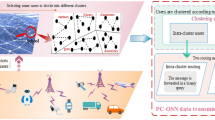Abstract
Under the complex environmental conditions of remote geographic locations and fragmented network areas, sending data over traditional wired networks or wireless self. Organizing networks often results in connection interruptions, packet loss and other problems. In order to reduce the problem of data loss due to network disruptions, researchers have proposed a new network technology for cut networks, named opportunity Network. Opportunity network messages have a high rate of packet loss due to factors such as the small probability of node encounters and message lifetime limits. In order to reduce the packet loss rate, improve the success rate of message transmission and reduce the message transmission delay, the paper proposes a node message transmission performance optimization model based on the fusion of neural networks and orthogonal experiments. The experimental results show that the prediction model proposed in the paper for optimizing node message transmission performance can predict the packet loss rate more accurately, and it is found that node density, node rate, and node cache are the most important factors influencing the message packet loss rate of the opportunity network, and the optimal settings of these three factors are obtained to reduce the packet loss rate of message transmission and improve the message delivery efficiency.
Access this chapter
Tax calculation will be finalised at checkout
Purchases are for personal use only
Similar content being viewed by others
References
Zhao, W., Ammar, M., Zegura, E.: A message ferrying approach for data delivery in sparse mobile ad hoc networks. In: Proceedings of ACM Mobihoc (2004)
Fall, K.: A delay-tolerant network architecture for challenged internets. In: Proceedings of the 2003 conference on Applications, technologies, architectures, and protocols for computer communications, pp. 27–34 (2003)
Yongping, X., Limin, S., Jianwei, N.: Opportunity network. J. Softw. 20(1), 124–137 (2009)
Zhi, R., Yong, H., Qianbin, C.: Routing protocols for opportunistic networks. J. Comput. Appl. 30(03), 723–728 (2010)
Wenwei, L., JIanguo, C., Zhimin, W.: A network packet loss rate measurement method based on self-adaptive sampling. J. Hunnan University (Nat. Sci.) 41(03), 107–112 (2014)
Ting, M.: The research on packet loss rate based on the measured data. Thesis (2015)
Vahdat, A., Becker, D.: Epidemic routing for partially-connected ad hoc networks. In: Handbook of Systemic Autoimmune Diseases (2000)
Weijie, C.: Buffer aware routing algorithm for opportunistic network. Softw. Guide 7, 80–83 (2019)
Spyropoulos, T., Psounis, K., Raghavendra, C.S.: Spray and wait: an efficient routing scheme for intermittently connected mobile networks. In: Proceedings of the 2005 ACM SIGCOMM Workshop on Delay-Tolerant Networking, pp. 252–259 (2005)
Musolesi, M., Hailes, S., Mascolo, C.: Adaptive routing for intermittently connected mobile ad hoc networks, pp. 183–189 (2005)
Dinghai, G., Xiaohang, H., Songhe, T.: Simulation studies of opportunity network applications in remote areas. J. HeChi Univ. 34(05), 66–71 (2014)
Ping, Z., Zhidong, Z., Shengzheng, W.: Packet forwarding protocol in coal mine opportunistic networks based on terminal attribute. China Sci. Paper 13(14), 1669–1673+1678 (2018)
Luquan, R.: Test Optimization Design and Analysis. Higher Education Press (2003)
Ruhe, D., Bihua, X., Yongshui, F.: Optimization test design method and data analysis, vol. 06, pp. 103–106. Chemical Industry Press (2004)
Haijun, G., Xingqi, H., Ming, D., Yaowen, Z.: Two indexes of design and analysis of orthogonal experiments about a novel phosphorus free builder. Comput. Appl. Chem. 03, 481–484 (2004)
Xiaolin, W., Bingjun, W., Qiang, Z.: Theoretical analysis methods and applications of quadrature test design. J. Anhui Inst. Archit. 27(03), 95–99 (2010)
Acknowledgement
This work was partially support by the National Natural Science Foundation of China under Grant 62061036, 61841109 and 61661041, Naturel Science Foundation of Inner Mongolia under Grand 2019MS06031, in part by the CERNET Innovation Project under Grant NGII20170622.
Author information
Authors and Affiliations
Corresponding author
Editor information
Editors and Affiliations
Rights and permissions
Copyright information
© 2021 Springer Nature Switzerland AG
About this paper
Cite this paper
Qi, Z., Pan, Y., Du, H., Zhang, N., Bai, Z., Xu, G. (2021). Opportunistic Network Performance Optimization Model Based on a Combination of Neural Networks and Orthogonal Experiments. In: Sun, X., Zhang, X., Xia, Z., Bertino, E. (eds) Artificial Intelligence and Security. ICAIS 2021. Lecture Notes in Computer Science(), vol 12737. Springer, Cham. https://doi.org/10.1007/978-3-030-78612-0_47
Download citation
DOI: https://doi.org/10.1007/978-3-030-78612-0_47
Published:
Publisher Name: Springer, Cham
Print ISBN: 978-3-030-78611-3
Online ISBN: 978-3-030-78612-0
eBook Packages: Computer ScienceComputer Science (R0)




